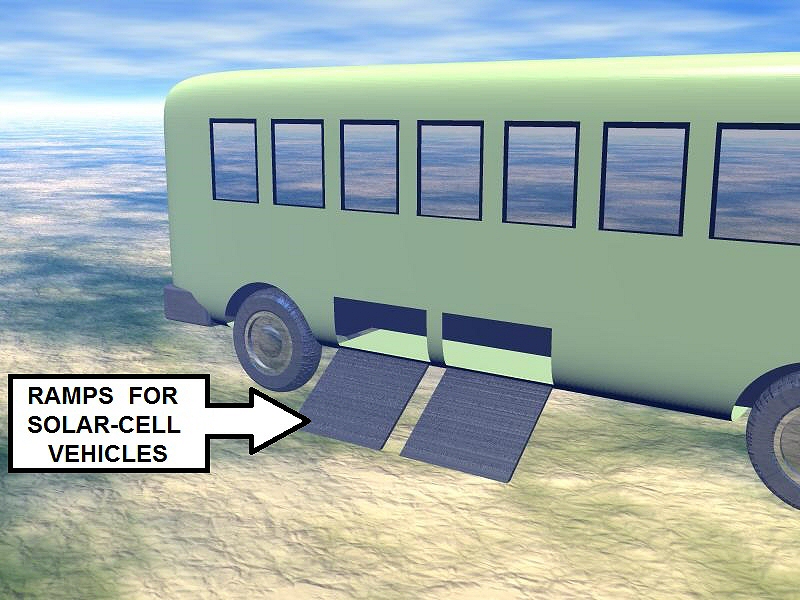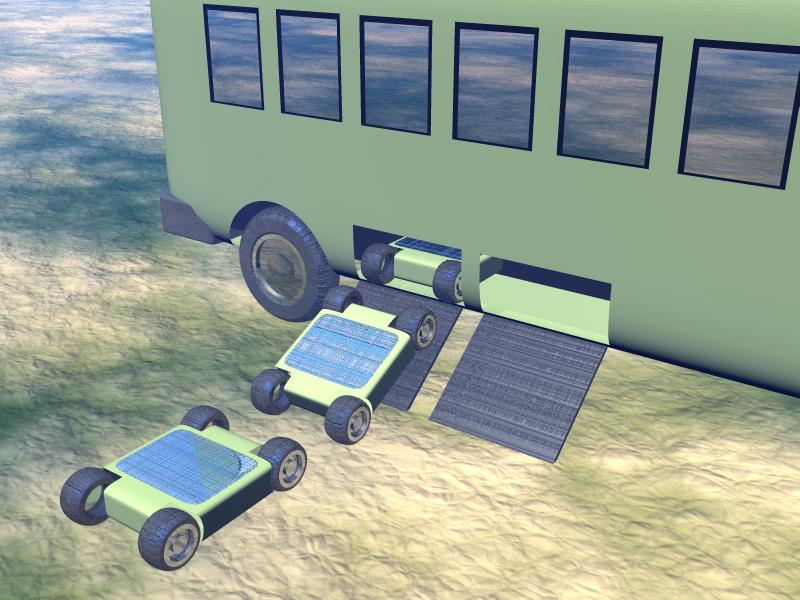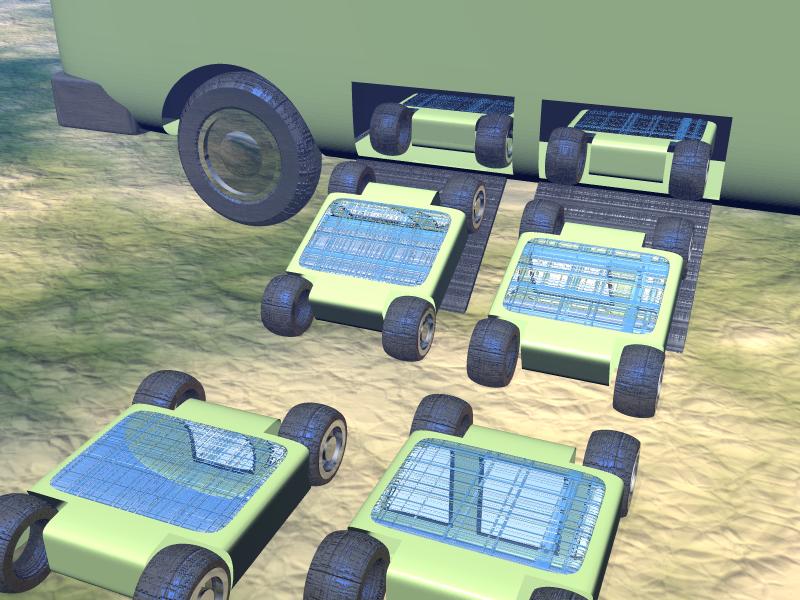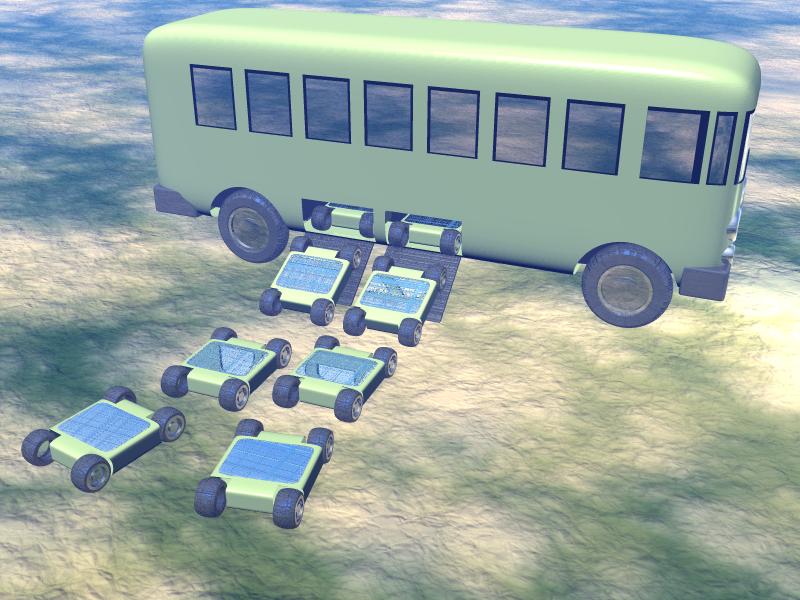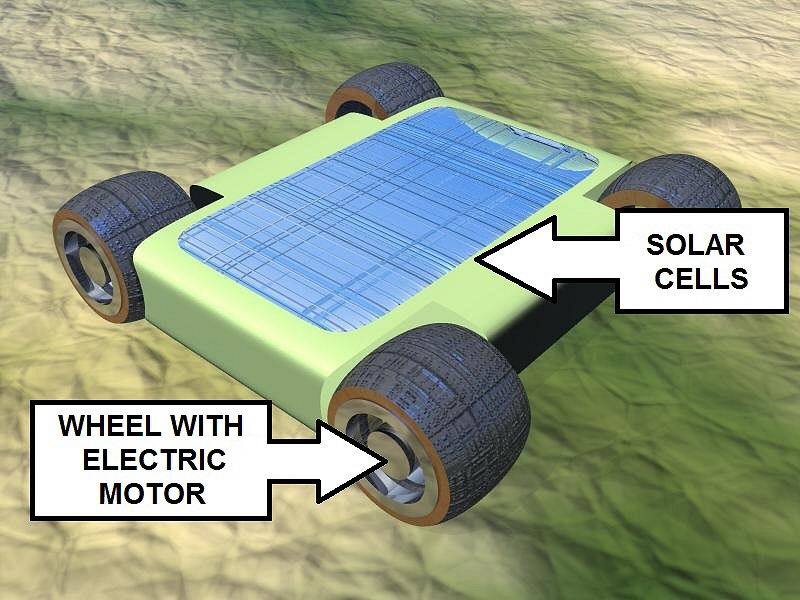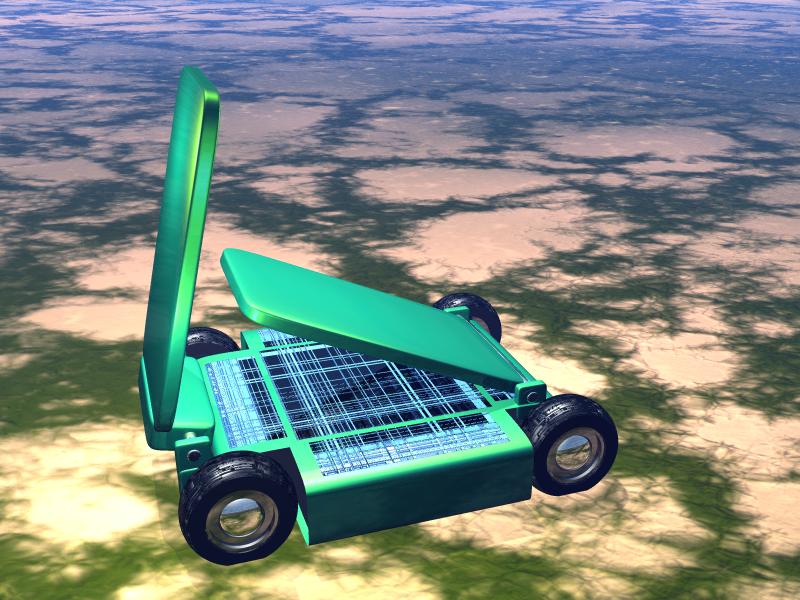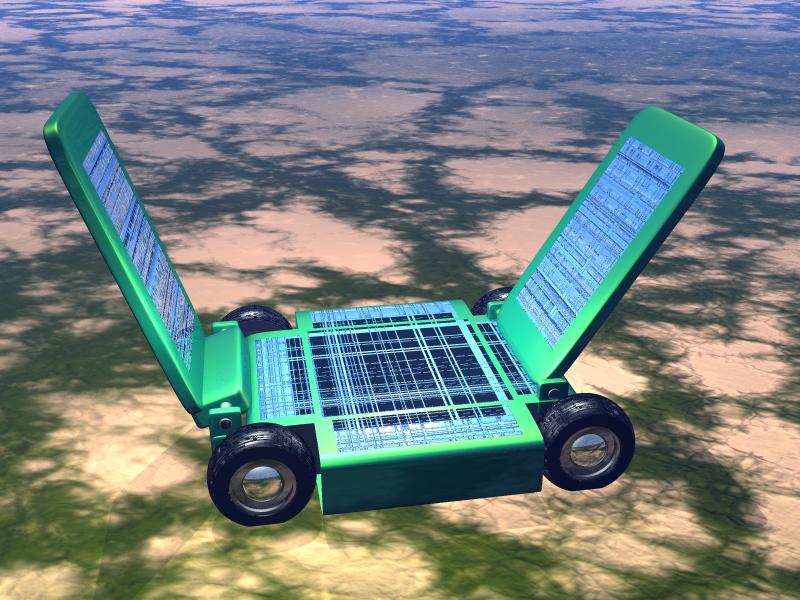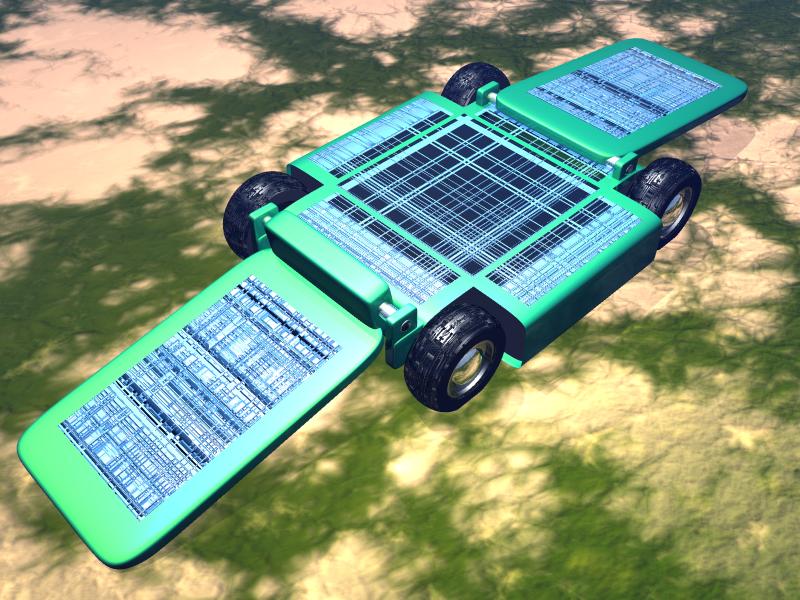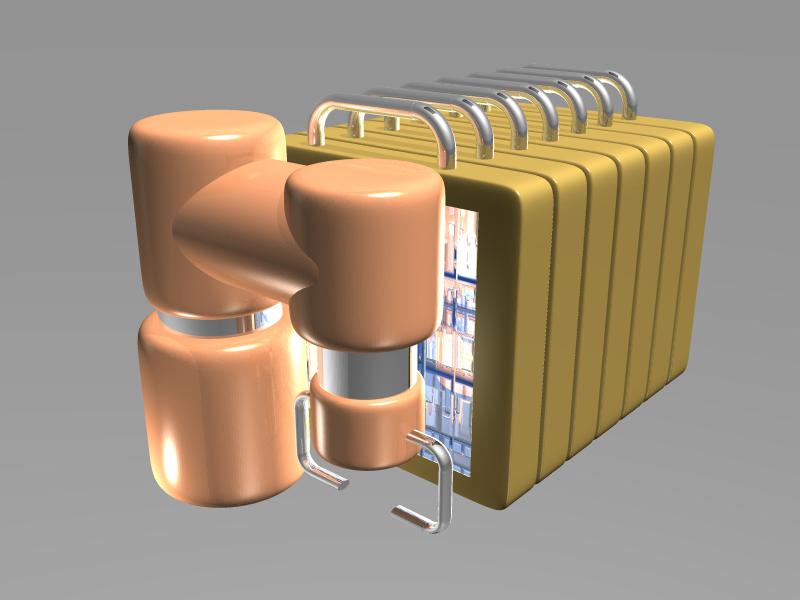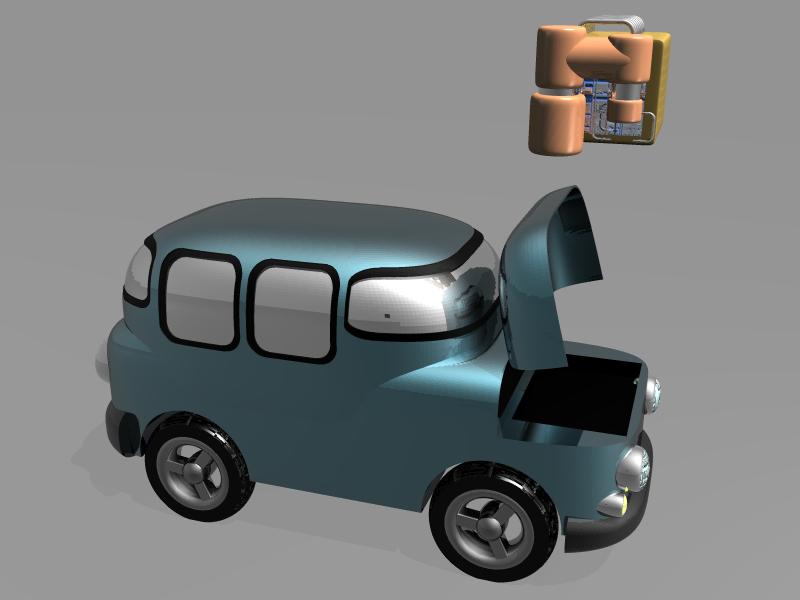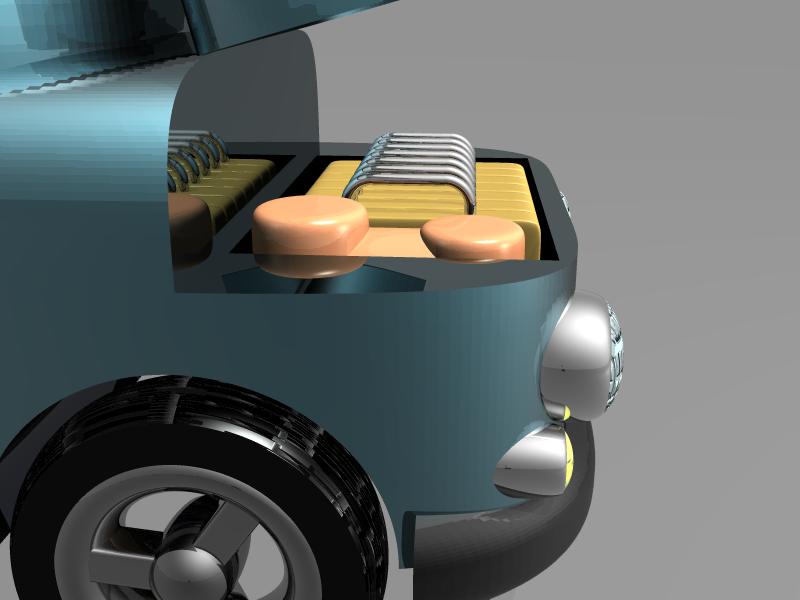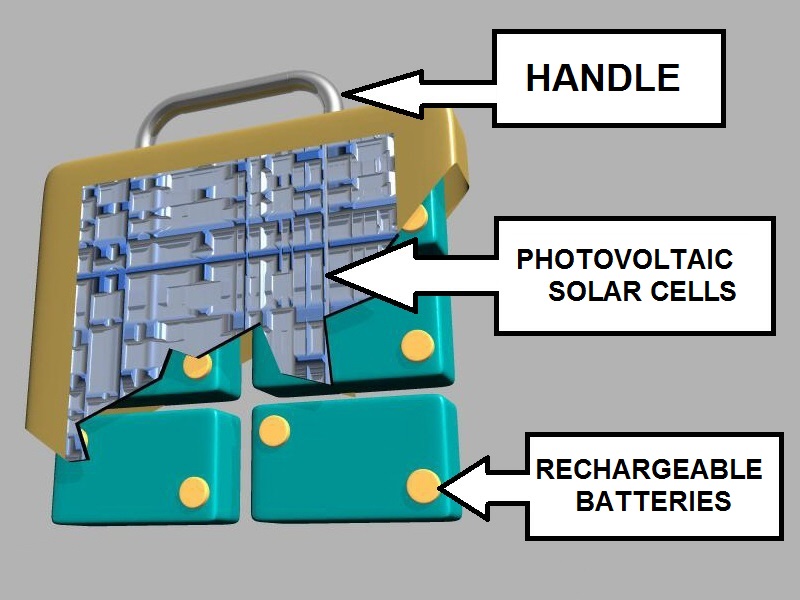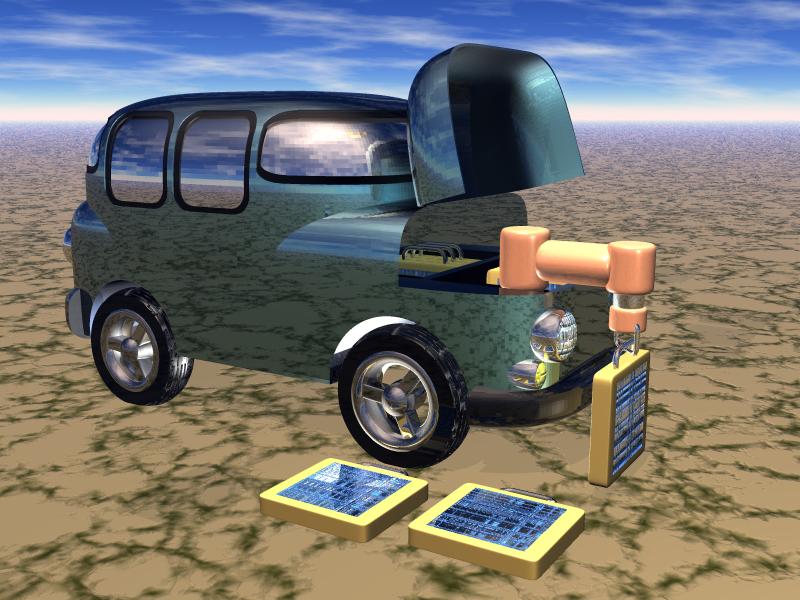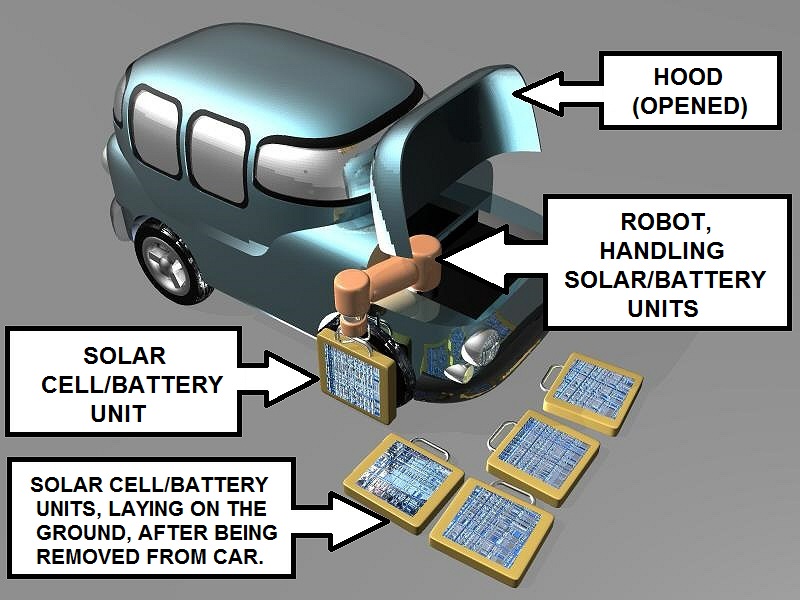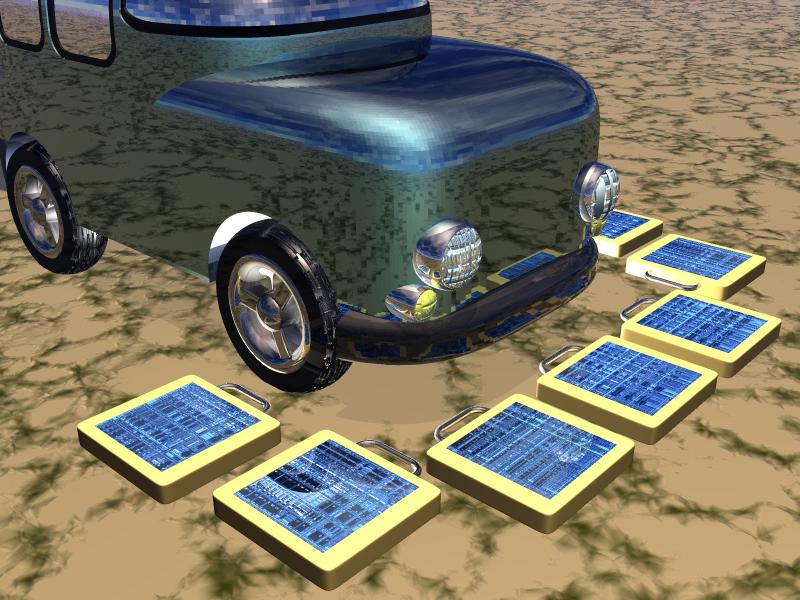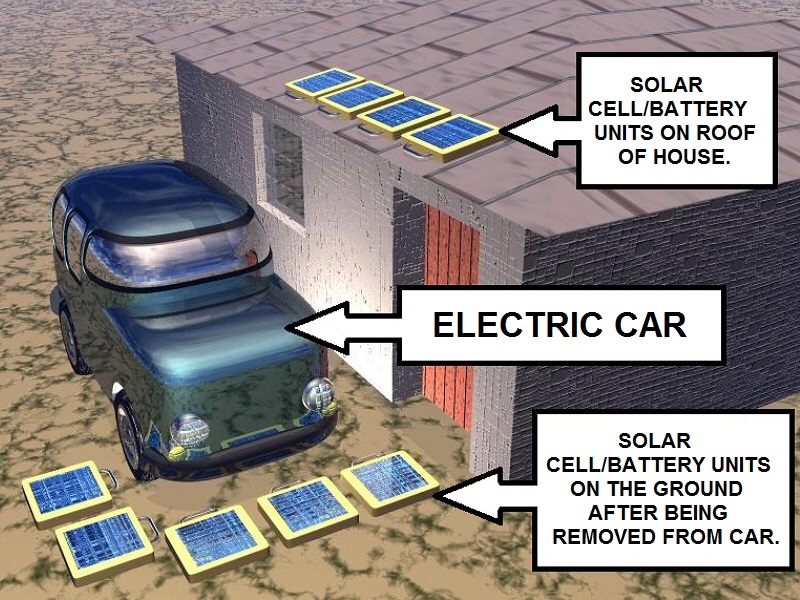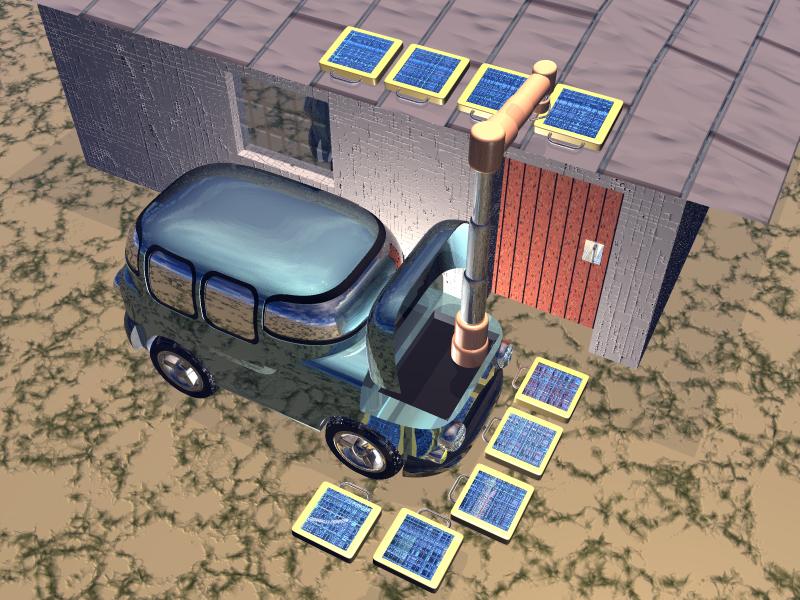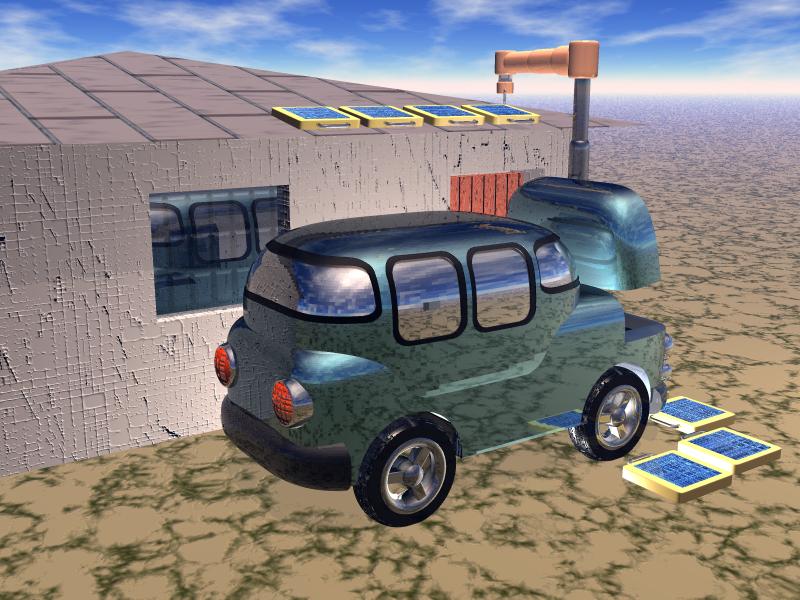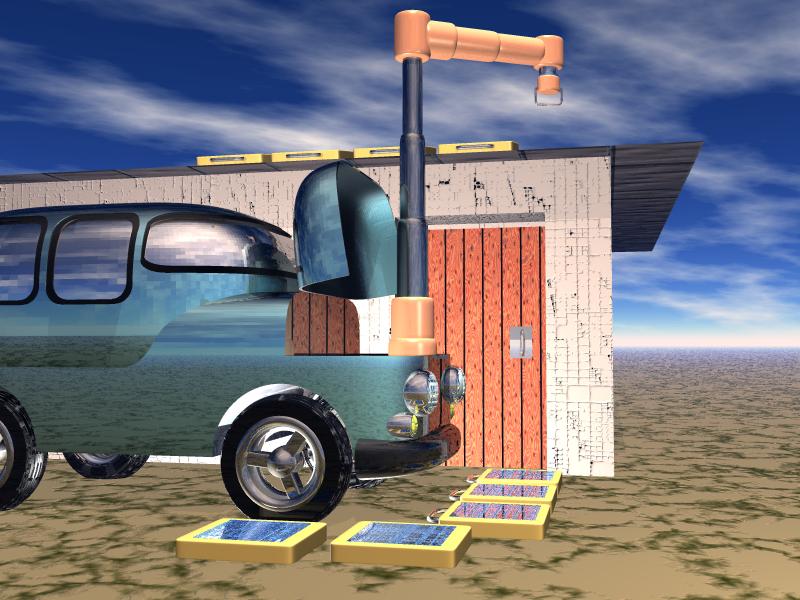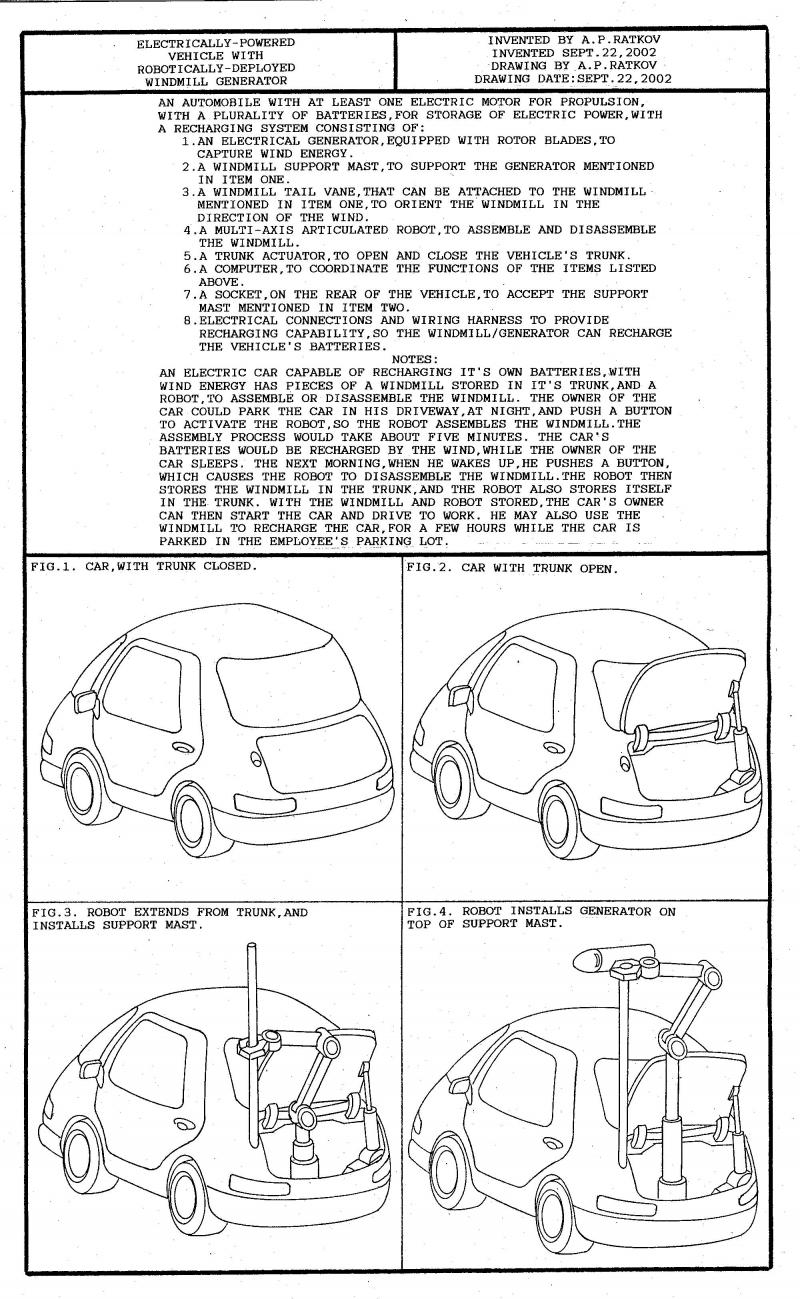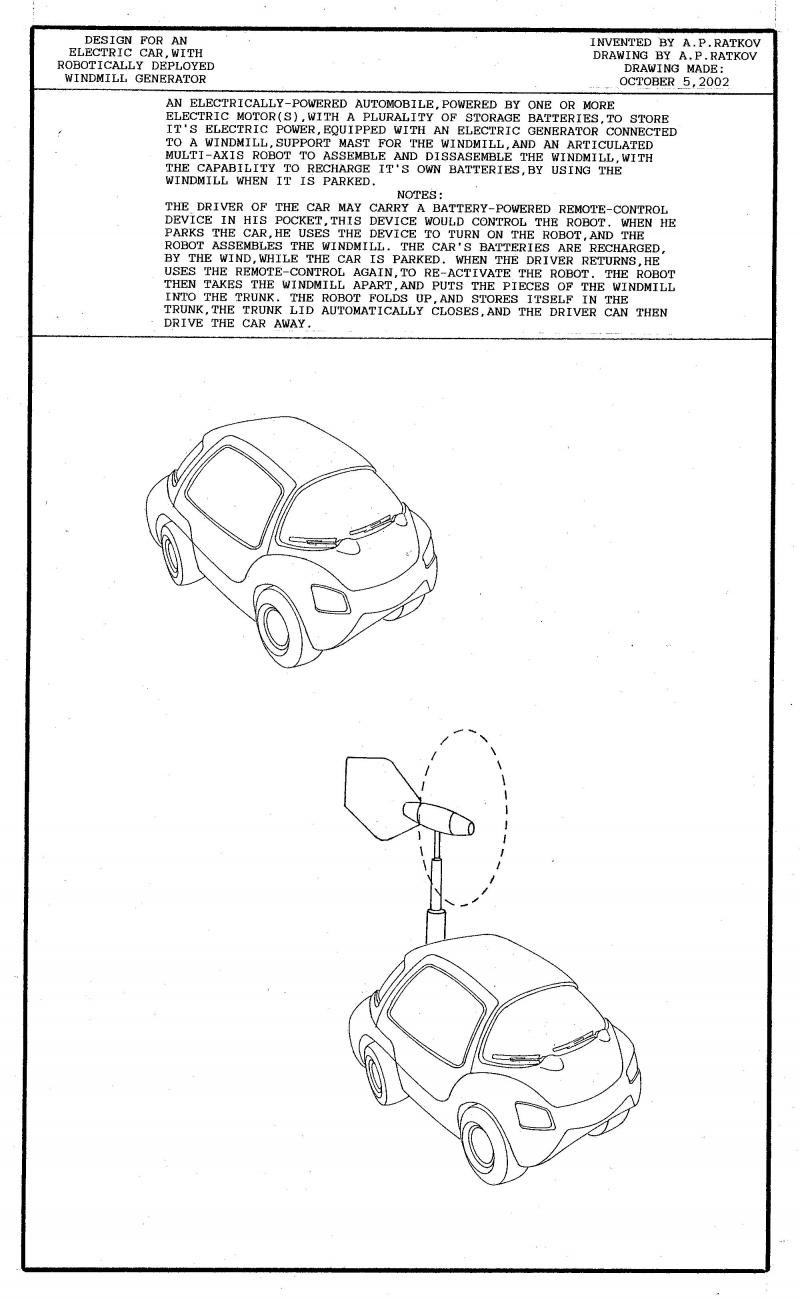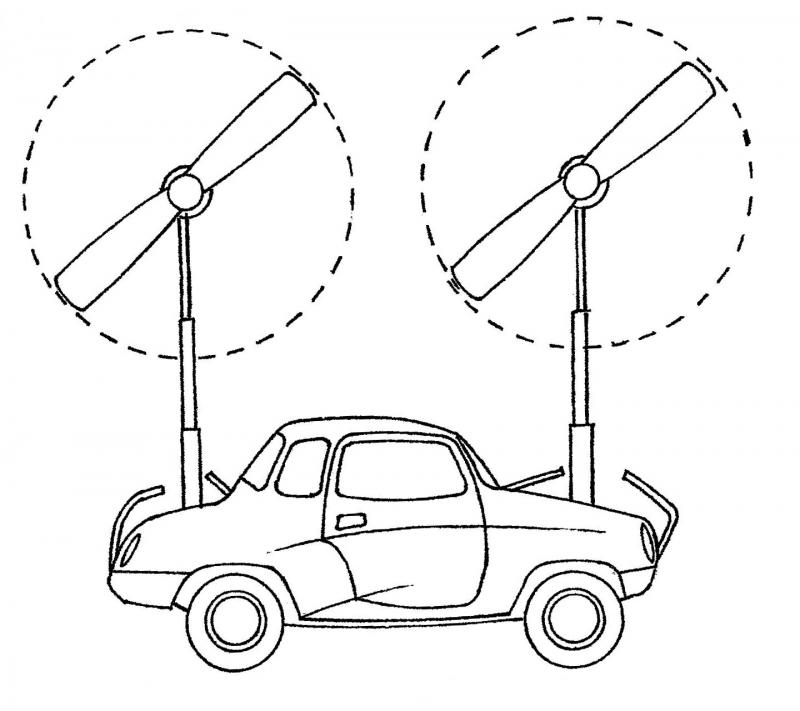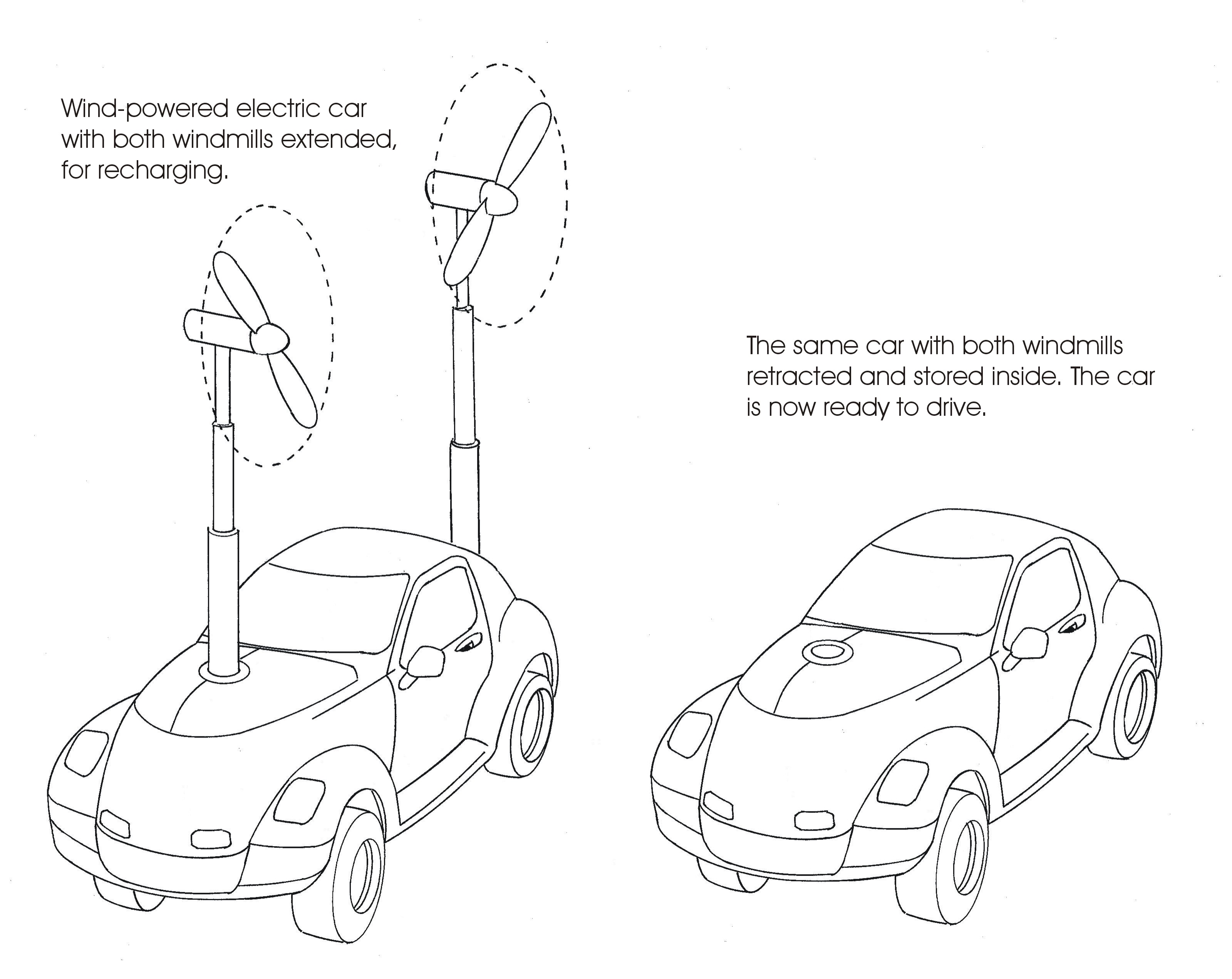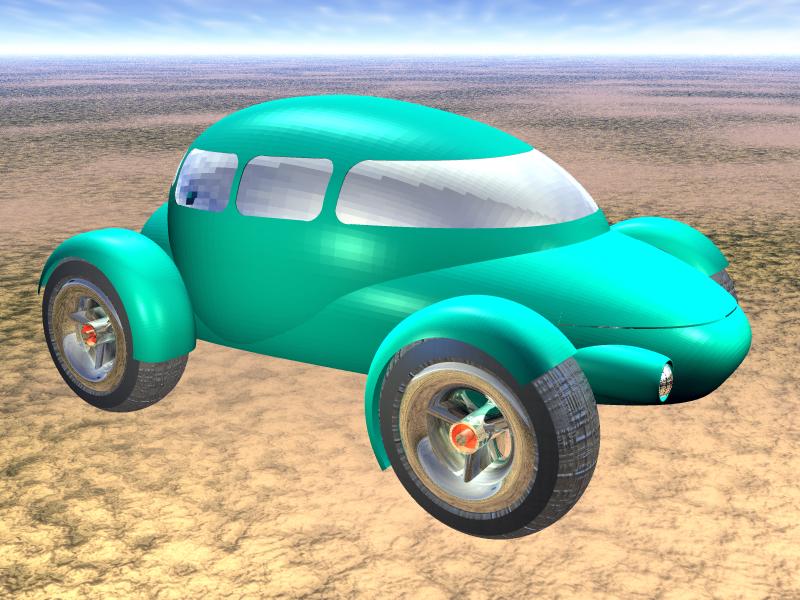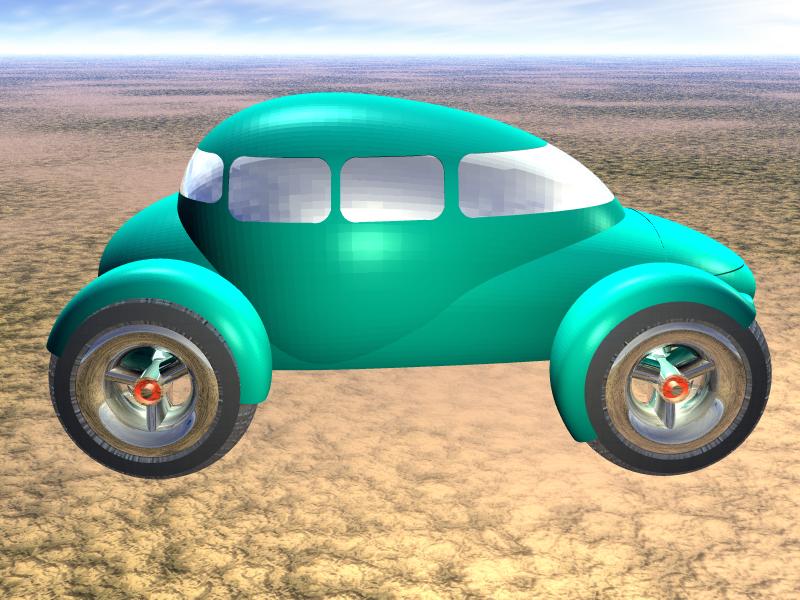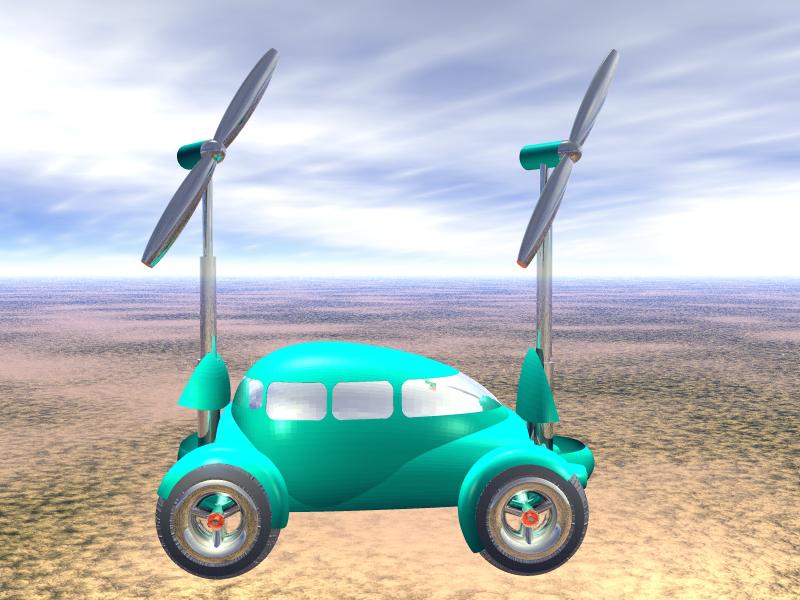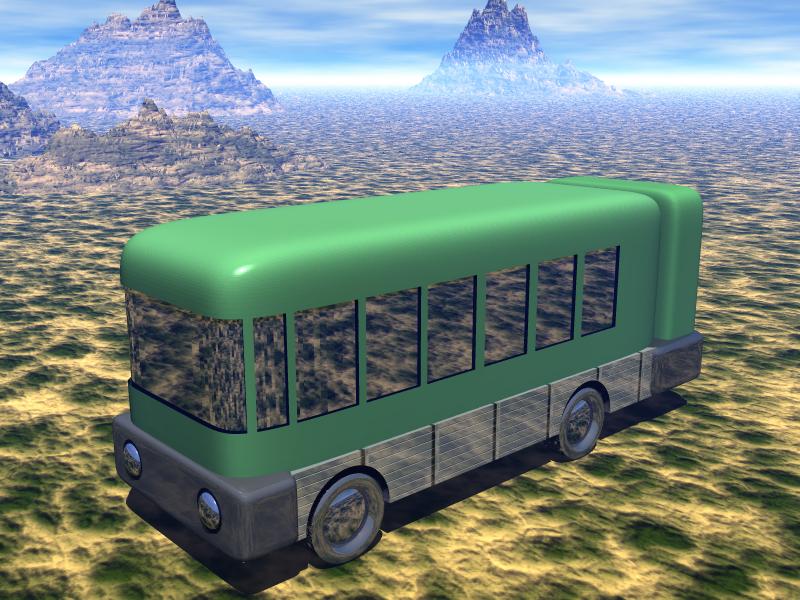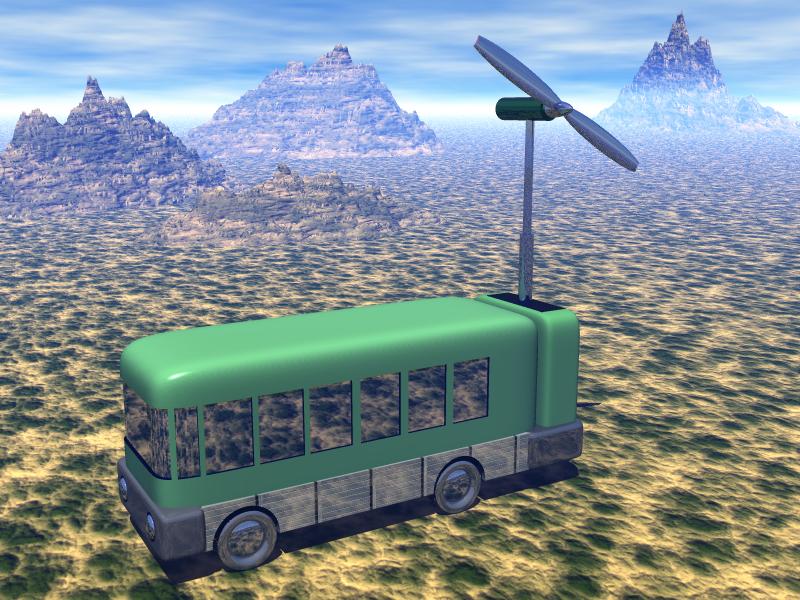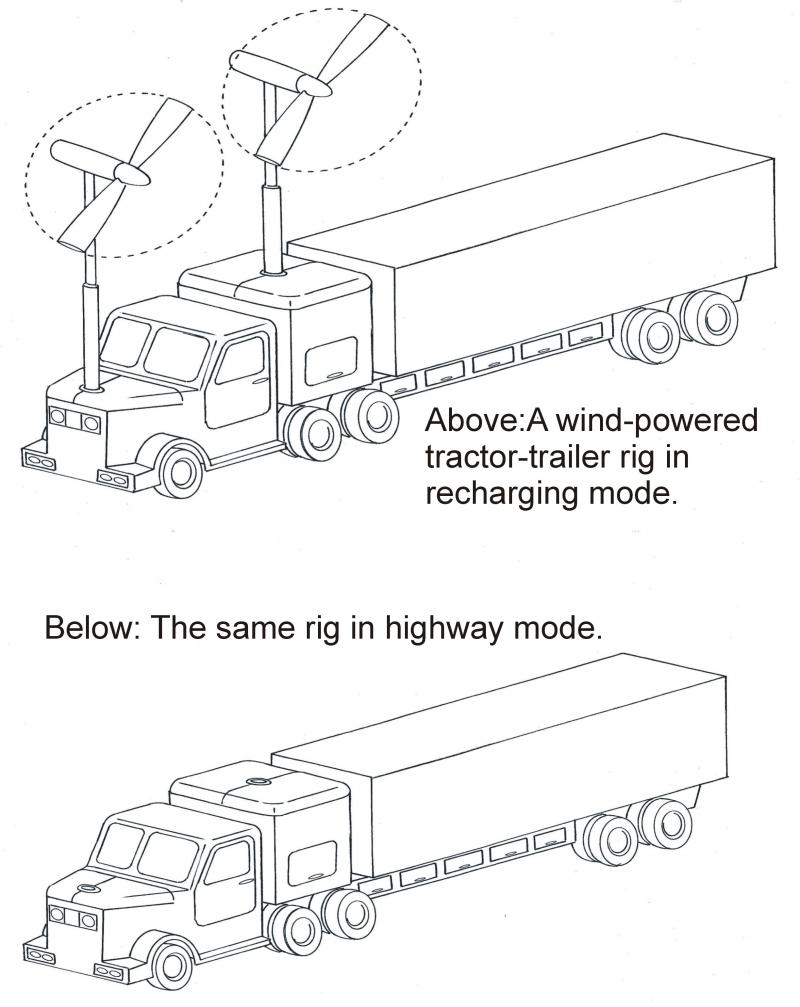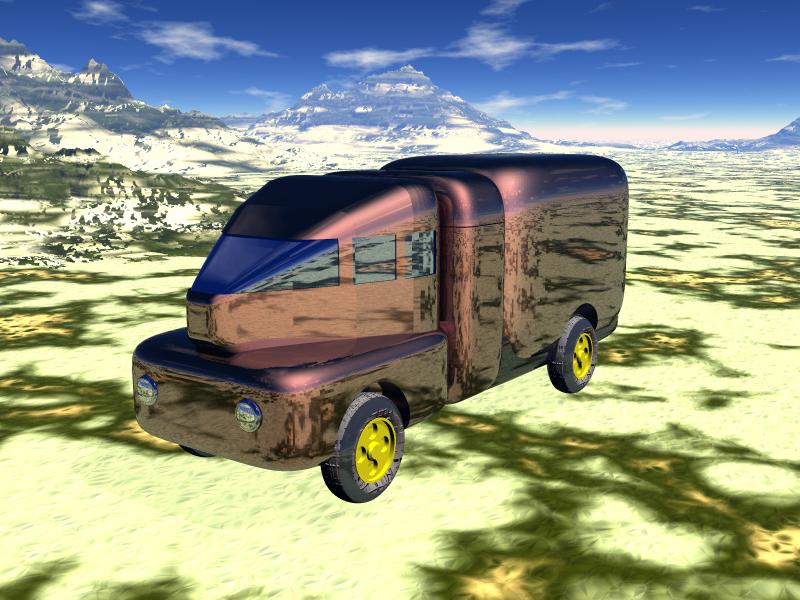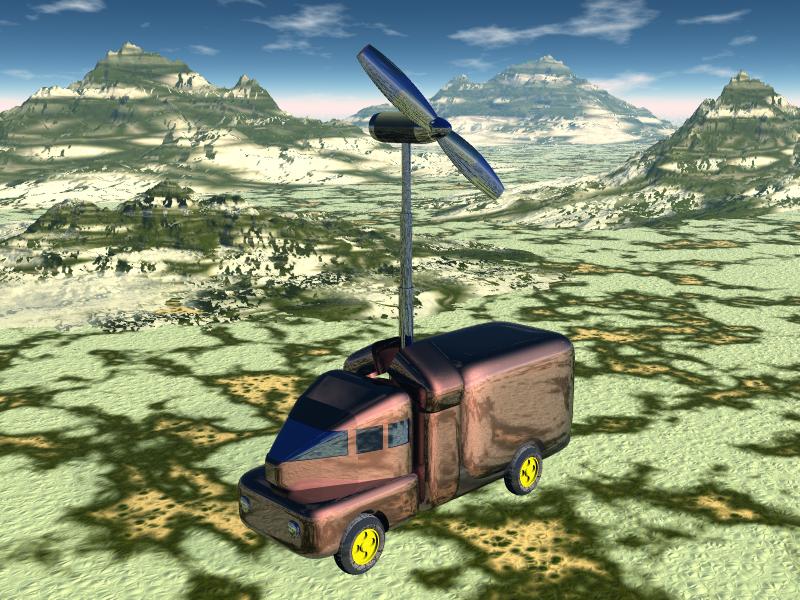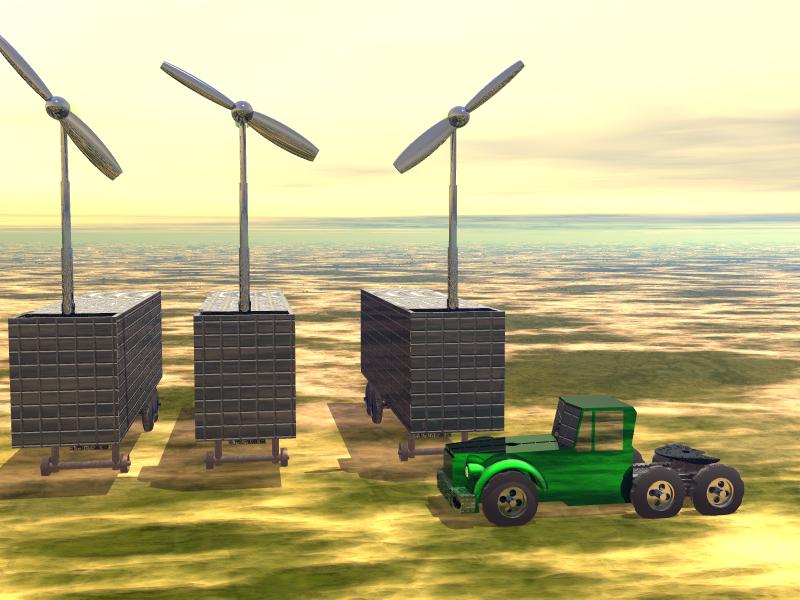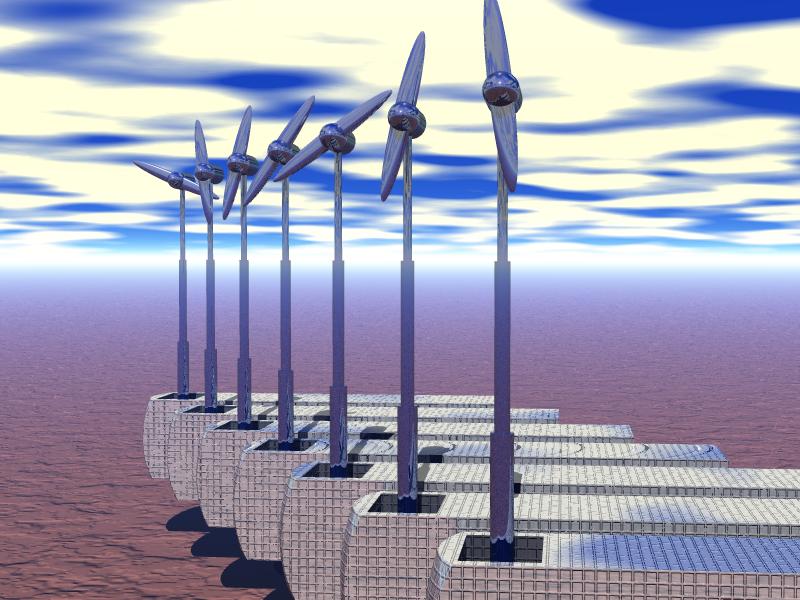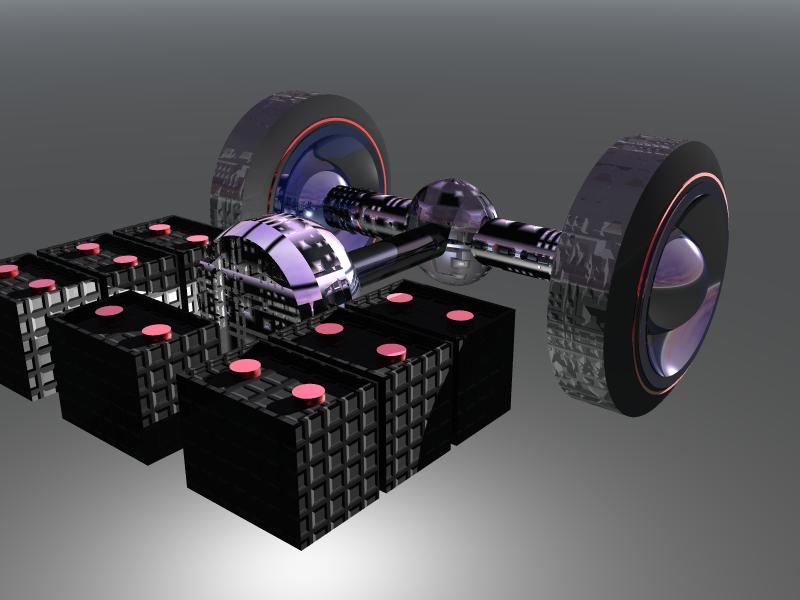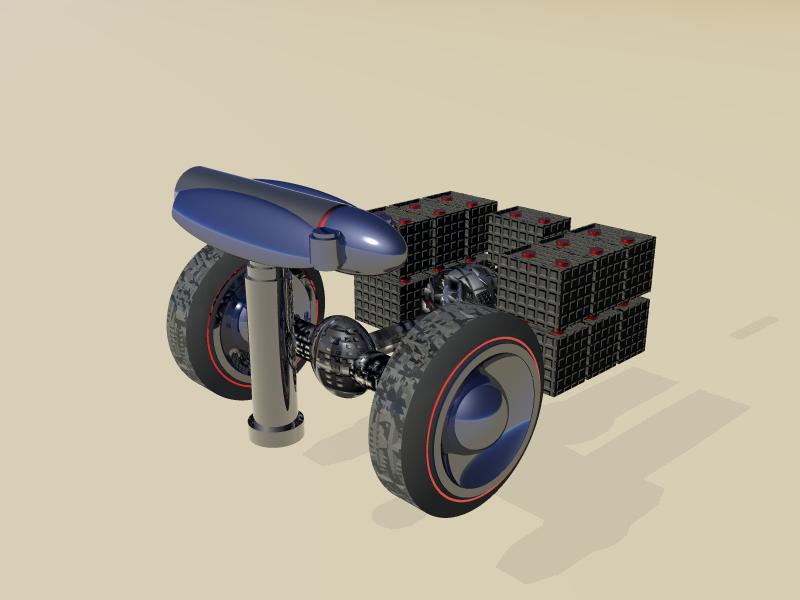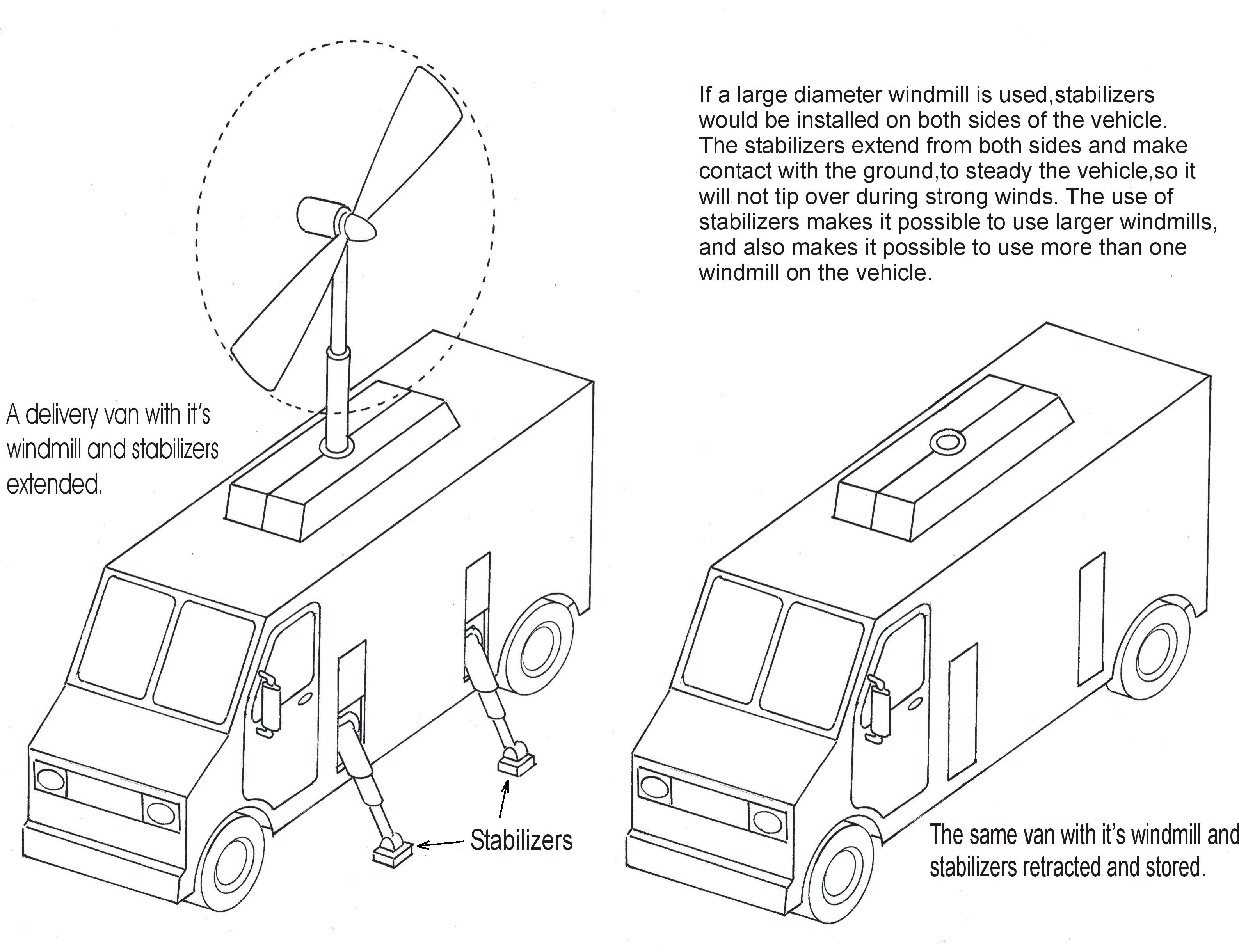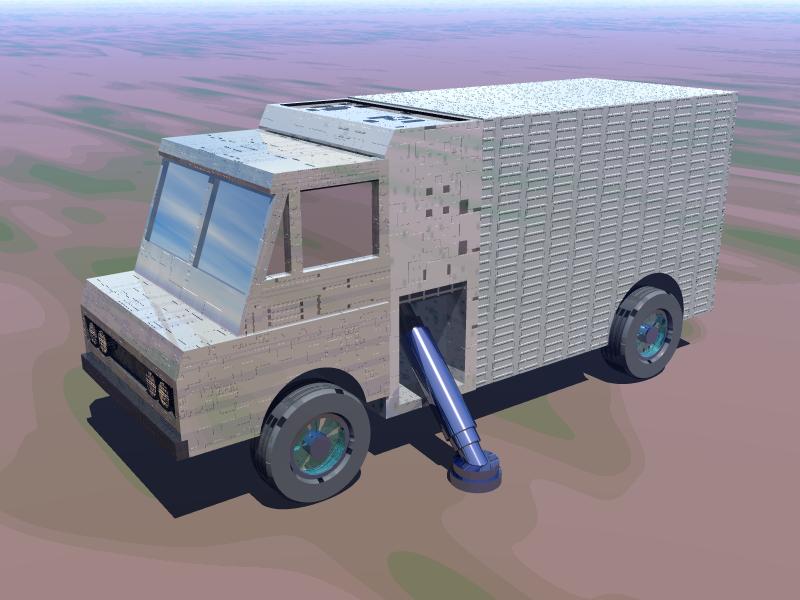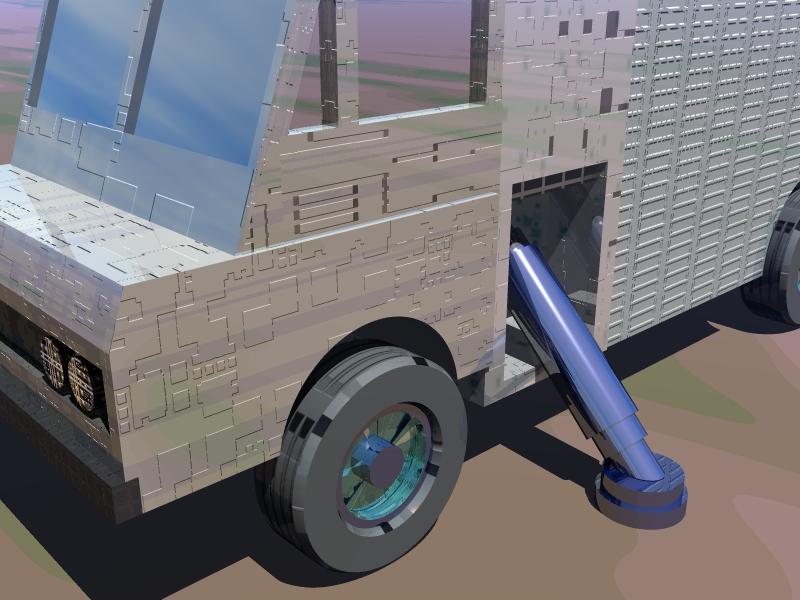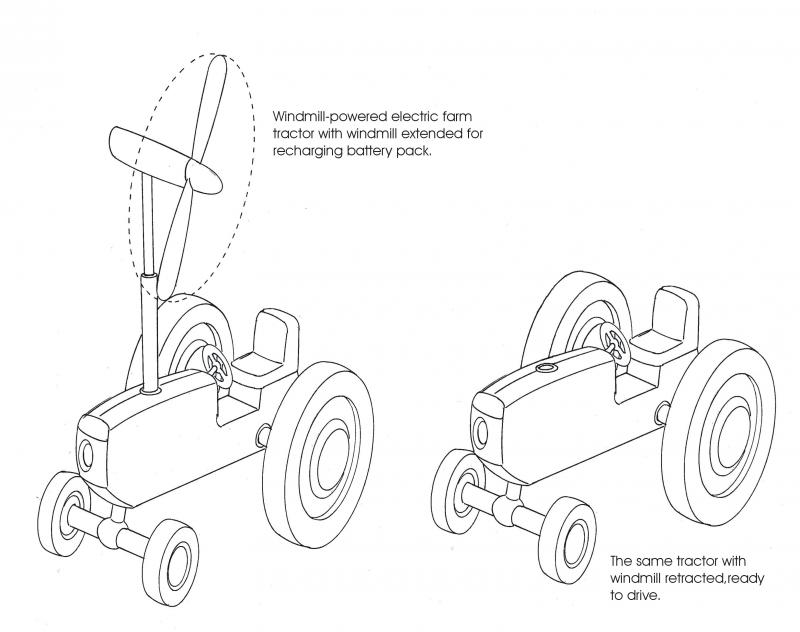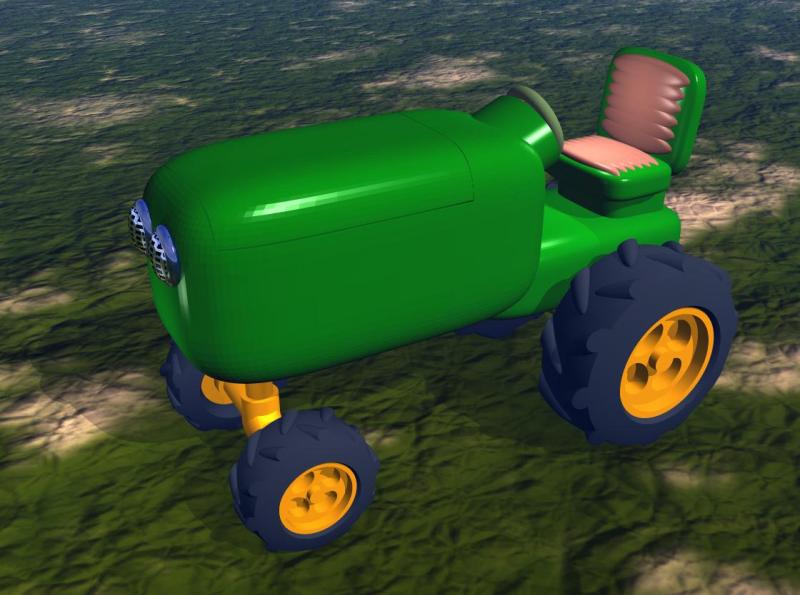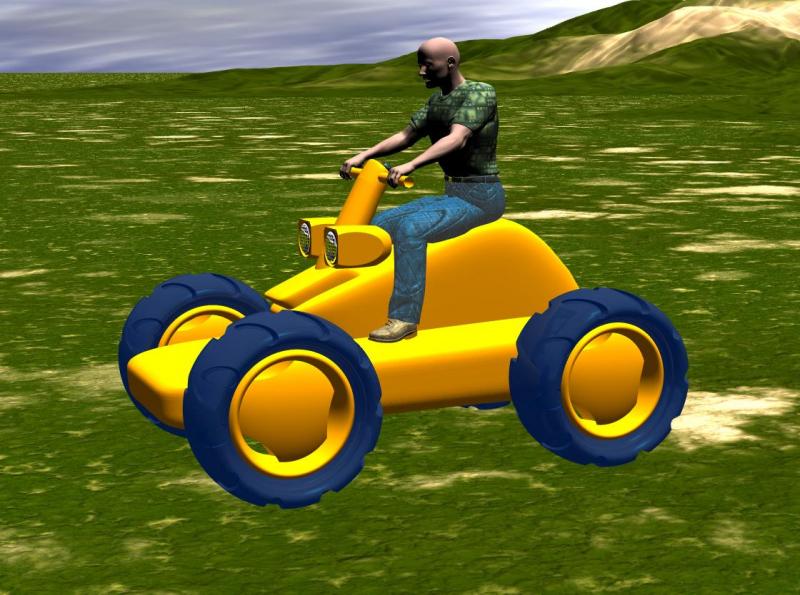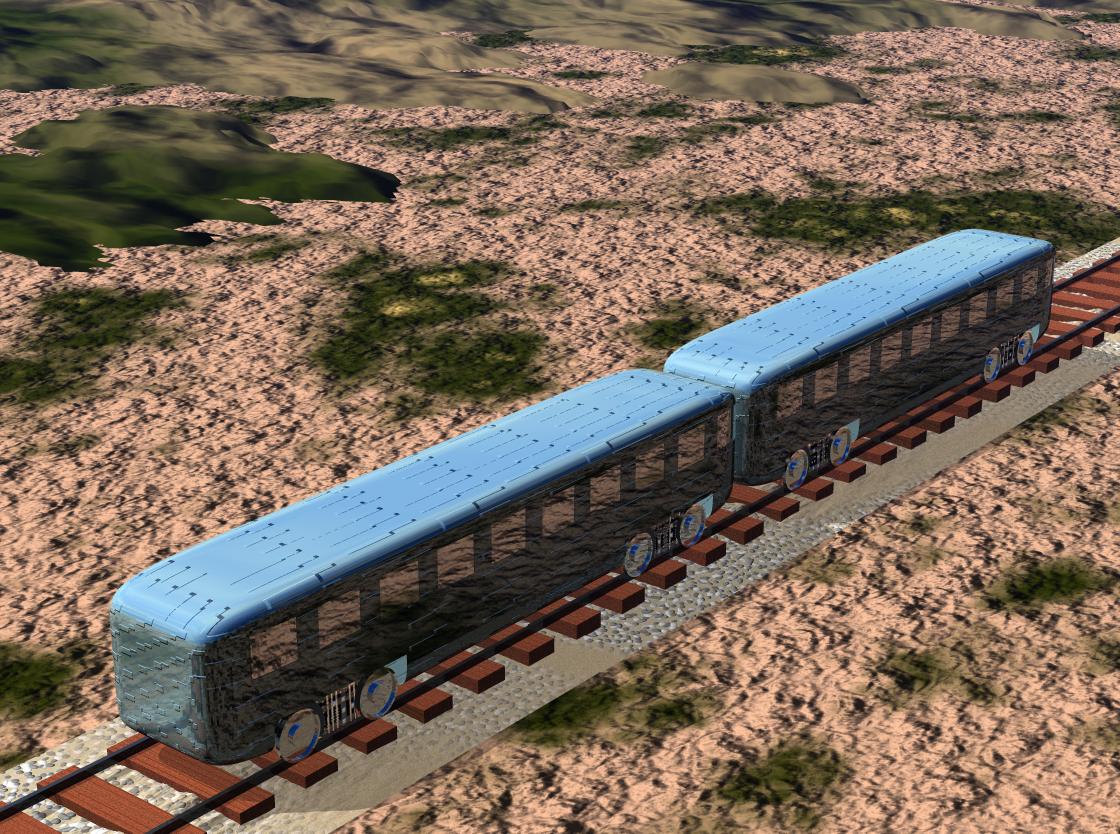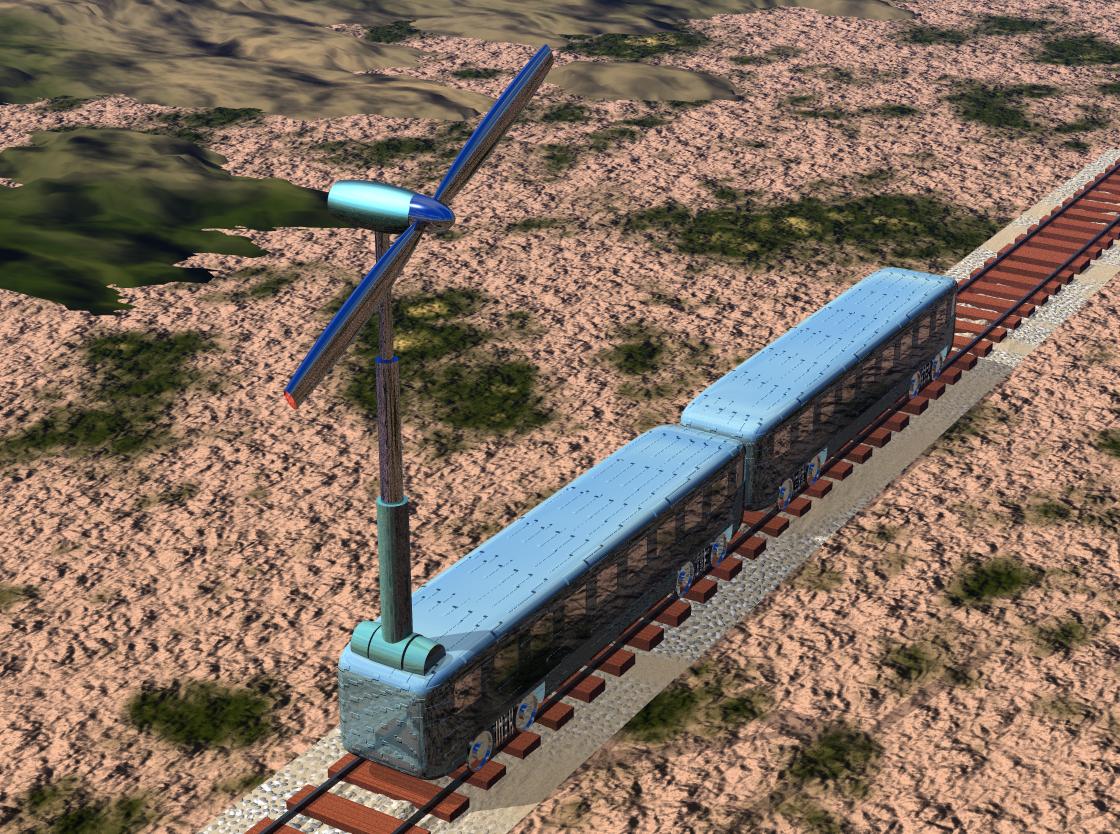anthonyratkov.info
Home Page
Alternative Energy Vehicles
Solar-powered vehicles
The illustration above shows an electric-powered bus, with ramps extending from the side of the bus.
The ramps are designed to allow battery modules to enter or leave the bus. Each battery module is a small vehicle, with wheels.
The illustrations above show the battery modules leaving the bus. As the modules leave, they will position themselves all around the bus.
The illustration above shows one of the battery modules. Each battery module is equipped with four wheels. The wheels are driven by electric motors, so the module can move under it's own power. Each module contains a rechargeable battery, and at least one solar panel.
The illustrations above show a battery module with a set of fold-out solar panels on it. After the module leaves the bus, the solar panels fold out. The bus would remain parked for several hours with it's solar modules arranged all around it. During this time, the solar modules receive light form the sun, the light they receive is converted into electricity, and the electricity is stored inside each battery module. After the modules have received a sufficient charge, the modules go back into the bus and they are automatically re-installed in the bus. During re-installation, they are connected to the electrical system of the bus, so they can provide power to the electric motors that drive the wheels of the bus.
The illustration above shows a solar-powered car. This car is an electric car with solar battery modules under the hood, there is also a robot under the hood. The robot is used to remove the battery modules from the car, and also to put the modules back into the car.
The illustration above shows a row of battery modules with a robot next to them. This entire package of equipment fits under the car's hood.
The illustrations above show how the battery modules and the robot that handles them fit under the car's hood.
The illustration above is a cut-away view of a battery module, showing the main parts of the module.
The illustrations above show how the robot removes each battery module from the car, and sets the modules down on the ground all around the car. The car will remain parked like this for several hours, while the solar battery modules are exposed to sunlight. The sunlight is converted into electricity, and the electricity is stored inside each module. After the modules have received a sufficient charge, the robot picks them up and puts them back into the car. When the modules are re-installed in the car, they are automatically connected to the car's electrical system, so they can provide power to the electric motors that drive the car's wheels.
The illustrations above show the car's robot lifting the battery modules and placing them on the roof of a house. If you don't have enough room in your driveway to lay all the modules out on the driveway, you may put the modules on the roof of your house instead. The modules would remain on the roof for several hours while they receive light from the sun,and after they are fully charged, the robot wold reach up and get them,and put them back into the car. Roof placement of the modules is an ideal alternative to placing the modules on the ground, especially for people who have small backyards, where there's not enough room in the backyard to lay all the modules on the ground.
Wind-powered Vehicles.
The illustration above is an illustration that was made November 1, 1998. It was my first drawing of a wind-powered car. A wind-powered car is an electric car that has a windmill stored inside of it. When the car is parked, the windmill is extended, so it can convert wind energy into electrical energy. The electricity that the windmill produces is stored in the car's batteries.
The illustrations above were made in September, 2002. In this invention, the parts of the windmill are stored in the trunk of the car, when the windmill is not in use. A robot in the trunk would remove the various parts of the windmill and would assemble the windmill. The car would remain parked like this for several hours while the windmill recharged the car's batteries. When the car's batteries were fully charged, the robot would take the windmill apart, and would put all the parts of the windmill back into the trunk for storage. When the windmill is stored in the trunk, you can drive the car like a normal car.
Above: an illustration of the wind-powered car made October 5, 2002.
Above: A newer version of the invention involved a self-assembling windmill. In this version of the invention, the windmill does not need a robot to assemble itself or to disassemble itself. The windmill would have mechanism built into it that would allow it to fold up or unfold without the aid of a robot. The date of this illustration is August 19, 2003.
Above: Illustrations of cars with dual windmills. If a car has two windmills instead of one, it's energy production capacity is doubled. The illustrations above were made in February, 2004.
The pictures above are computer-graphic illustrations that show an electric car with dual windmills.
Above: An illustration of a wind-powered bus, with four windmills. This illustration was made in February, 2008.
The two illustrations above are computer-graphic images that show a wind-powered electric bus. In the upper picture, the windmill of the bus is retracted. In the lower picture, the windmill of the bus is extended.
The illustration above shows a fleet of buses parked on a parking lot with their windmills extended so they can recharge their batteries.
The illustration above shows an electric truck with windmills for recharging it's batteries. This illustration was made on February 22, 2008.
Above: Additional drawings of windmill-powered electric trucks, these drawings were made in 2008.
Above: Computer-graphic images of windmill-powered electric trucks.
The illustrations above show a windmill-electric power plant for a vehicle.
Since the wind exerts a lateral force on the windmill, stabilizers may be used to prevent the vehicle from tipping over in strong winds. The illustrations above show stabilizers that extend from both sides of the truck.
Above: Illustrations of windmill-powered electric farm tractors.
Above: An illustration of a windmill-powered electric recreational vehicle being ridden.
Above: An illustration of a windmill-powered electric recreational vehicle that has been parked, so it can recharge it's batteries. It will remain parked like this for several hours, while it's batteries are recharged with wind energy.
Wind-powered vehicles can also ride on railroad tracks. The illustration above shows a train, on a set of railroad tracks.
Occasionally the train will stop to recharge it's batteries. When the train stops, it will raise a retractable windmill, and the blades of the windmill will automatically unfold. The train will remain parked like this for several hours while it's batteries are recharged. When the train's batteries are fully charged, the windmill will be retracted, folded up and put back into storage. The illustration above shows a wind-powered electric train.
The links below can connect you to articles written by Anthony Ratkov:

